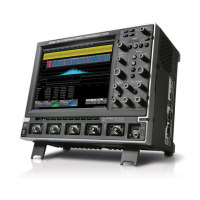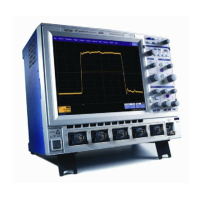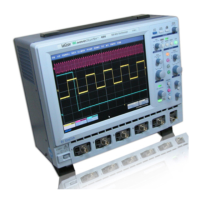378 WM-OM-E Rev I
containing many. It is not possible to compare a split sector with an unsplit or differently
split sector.
Using Analog Compare
This method compares a reference signal to subsequent acquisitions and looks for large changes
in the waveform. It is a general purpose test method that can be applied to finding errors in
practically any signal, including VCO Synchronization fields, data and servo-information.
The user stores a "good" reference analog waveform. On subsequent acquisitions the filter, if
selected, equalizes the newly acquired waveform. Analog Compare then attempts to measure the
bit cell time and to find the end of VCO Synch, on both the stored reference and the acquired
waveforms. If that succeeds the comparison starts, aligned by the marks at the end of VCO Synch.
If the waveforms being compared do not contain VCO Synch, or if Read Gate is not used, the
message "Could not analyze VCO Synch at start of signal" is displayed. This is just a warning, in
case it is believed that VCO Synch ought to have been found. Analog Compare will proceed
anyway.
Analog Compare computes the mean squared distance (msd) between the stored reference
waveform and the head signal, over a 3-byte-wide window. The two waveforms are aligned to the
nearest sample at the start. As the window is moved across the waveforms, alignment to the
nearest sample is maintained as long as the timing in the reference is within 1% of the timing of the
head signal. When the normalized msd exceeds the user-set Analog Threshold, an error will be
recorded on the error list; the position of the maximum difference in the reference and the head
signal is recorded. If the difference remains above threshold for more than the length of an encoded
byte, a new error is recorded at each byte. Errors are ordered in the error list from largest to
smallest difference.
Analog Compare requires some setup, and a stored reference signal to compare to before it can be
used. The following must be provided.
Head Signal: As with the other methods, the head signal is essential for Analog Compare. Unlike
the other methods, however, Analog Compare will work on any part of the head signal.
Reference: The stored reference should be acquired in the same manner (same time/div, sample
rate, trigger position, etc) as the acquisitions that will be compared to it. See Note 3 below.
Analog Threshold: This is the user-specified threshold used by Analog Compare to decide when
to record an error. A typical value for the Analog Threshold might be about 0.025. See Note 1
below.
Additionally, these parameters are useful (but not essential) for Analog Compare:
Read Gate: If the Read Gate signal is available, it will be used as described in Note 2, below.
Read Gate Polarity: Typically, Read Gate is a positive true signal. However, there are drives that
use a negative true signal for Read Gate. If Read Gate is enabled, this setting allows you to select
whether "True" is high or low.
Read Clock: If present, the Read Clock signal is used to determine where the "sample time"
markers are drawn.
Use Analyze Region: As previously described, markers can be used to define a subset of the head
